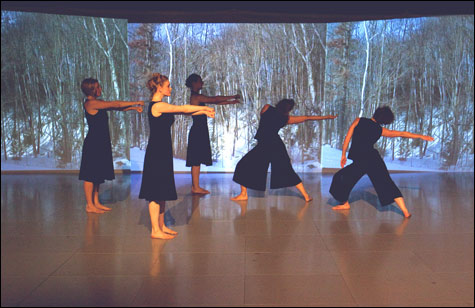
"WINTER" In the course of Pierce's Requiem, the dancers changed into black, and the trees of the backdrop stood ankle-deep in snow. |
Mozart's Requiem is one of the most controversial works in the classical repertory. Mozart had completed only parts of it and sketched other parts when he died, unexpectedly at age 35, in 1791. His death ignited immediate speculation and myth -- in recent times, Peter Shaffer's play Amadeus and the film based on it by Milos Forman give the best-known fictionalized account -- and the Requiem too was enveloped in mystique.
It's not known exactly which of Mozart's followers and associates were enlisted by his widow, Constanze, to finish the Mass, or the degree to which Mozart's intentions were fulfilled. Adjustments were made by later editors and arrangers; performances over the years have put forth differing interpretations. There's still no definitive version.
Nicole Pierce, who's a musician as well as a dancer/choreographer, has plunged into the fray with her Requiem, for eight women of EgoArt, a piece that had its premiere last weekend at the Armory Center for the Arts in Somerville. In a program preamble, Pierce explains why she set her work to Herbert von Karajan's 1975 recording with the Berlin Philharmonic Orchestra, and why even that performance doesn't quite suit her own idea of the Requiem. I left the Armory a bit puzzled about how her choreography relates to this problematic masterpiece.
The Catholic Church's Requiem Mass intersperses sections of the ordinary Mass with predictions of the doom that awaits the unfaithful and their prayers for salvation. A lot of it is quite scary. The singers envision the flames of Hell, the terror of Judgment, the miraculous appearance of a kind intercessor. Mozart's final image is of eternal light ("Lux æterna") and mercy.
Pierce's note didn't identify the soloists or the chorus on this recording, and the voices were often muffled by the Armory's shrill amplification. In any case, she seemed focused on the music and not the words; her formally structured dance only tangentially reflected the text.
Instead of illustrating Mozart's pleadings and death visions, the dancers used a language that was part balletic, part invented modern-dance body movement. Avoiding the obvious gestural correlations for praying, suffering, and dying, they conveyed emotional tone in fast-changing sequences of twisting, crouching, falling, tilting, hopping, flinging, balancing, and leaping. Partnering each other, they exchanged roles, wrapping bodies together in effortful angles. In another section, two women lifted each other straight up and pivoted in a new direction. The well-made floor patterns and groupings were always formal, constantly changing, attuned to the music.
The entire dance took place in a big white space, with the audience seated on three sides and panoramic pictures of a forest surrounding the performers. (The video installation was by Pierce.) At first, the trees were dense and still; later I noticed we were looking at a different scene and a breeze was blowing the branches around. This visual backdrop changed imperceptibly; the green of summer dissolved into the bronze of fall, and then the trees stood ankle-deep in snow.
During the course of the seasons, the dancers changed costumes, from white dresses and pants to gray and then black. I thought Pierce was indicating a transition from life to death. But in a larger sense, Mozart's scenario goes the other way, from trouble and sorrow to life everlasting.